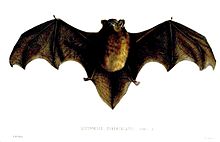| New Zealand long-tailed bat | |
|---|---|

| |
| Scientific classification | |
| Domain: | Eukaryota |
| Kingdom: | Animalia |
| Phylum: | Chordata |
| Class: | Mammalia |
| Order: | Chiroptera |
| Family: | Vespertilionidae |
| Genus: | Chalinolobus |
| Species: | C. tuberculatus
|
| Binomial name | |
| Chalinolobus tuberculatus (Forster, 1844)
| |
Chalinolobus tuberculatus, known more commonly as the New Zealand long-tailed bat, the long-tailed wattle bat or pekapeka tou-roa, is a small insectivorous mammal within the genus Chalinolobus.[2] The long-tailed bat is one of 7 species belonging to the genus Chalinolobus, which are commonly referred to as “wattled bats,” “pied bats” and “long-tailed bats."[3] The genus Chalinolobus is characterised by fleshy lobes located on their lower lips and at the bottom of their ears.[4] Some zoologists claim there is overlap between the Chalinolobus genus and the Glauconycteris genus.[5]
The long-tailed bat is one of two extant and three total terrestrial mammals endemic to the islands of New Zealand.[2] The other extant species being the New Zealand Lesser Short-Tailed Bat (Mystacina tuberculata).[2] The long-tailed bat is closely related to 6 other species of wattled bats found in Australasia, namely Gould’s Wattled Bat (Chalinolobus gouldi) the largest of the species belonging to the Chalinolobus genus.[6] The long-tailed bat won the 2021 Bird of the Year competition in New Zealand, despite not being a bird.[7]
- ^ O'Donnell, C. (2021). "Chalinolobus tuberculatus". IUCN Red List of Threatened Species. 2021: e.T4425A21985132. doi:10.2305/IUCN.UK.2021-1.RLTS.T4425A21985132.en. Retrieved 10 October 2024.
- ^ a b c O’Donnell, Colin F. J. (2000). "Conservation status and causes of decline of the threatened New Zealand Long-tailed Bat Chalinolobus tuberculatus (Chiroptera: Vespertilionidae)". Mammal Review. 30 (2): 89–106. doi:10.1046/j.1365-2907.2000.00059.x. ISSN 0305-1838.
- ^ Breed, W. G; Inns, R. W (1985). "Variation in sperm morphology of Australian Vespertilionidae and its possible phylogenetic significance". Mammalia. 39 (1): 105–108. doi:10.1515/mamm.1985.49.1.105 – via De Gruyter.
- ^ Law, Bradley; Eby, Peggy; Lunney, Daniel; Lumsden, Lindy, eds. (2011). The Biology and Conservation of Australasian Bats. P.O. Box 20, Mosman NSW 2088, Australia: Royal Zoological Society of New South Wales. doi:10.7882/fs.2011.026. ISBN 978-0-9803272-4-3.
{{cite book}}: CS1 maint: location (link) - ^ Peterson, Randolph L.; Peterson, Randolph L.; Smith, Donald Alan; Museum, Royal Ontario (1973). A new species of Glauconycteris (Vespertilionidae, Chiroptera). Toronto: Royal Ontario Museum. doi:10.5962/bhl.title.60686.
- ^ Lumsden, Linda F.; Bennett, Andrew F.; Silins, John E. (1 August 2002). "Location of roosts of the lesser long-eared bat Nyctophilus geoffroyi and Gould's wattled bat Chalinolobus gouldii in a fragmented landscape in south-eastern Australia". Biological Conservation. 106 (2): 237–249. Bibcode:2002BCons.106..237L. doi:10.1016/S0006-3207(01)00250-6. ISSN 0006-3207.
- ^ "Bat swoops in for upset victory in New Zealand's prestigious Bird of the Year contest". NBC News. 1 November 2021. Retrieved 10 October 2024.

